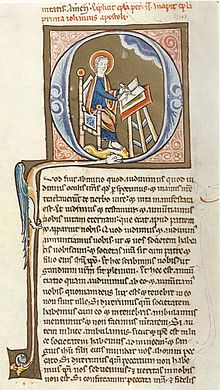1st letter of John
| New Testament |
|---|
| Gospels |
| Acts of the Apostles |
| Paul's letters |
| Catholic letters |
| epiphany |
The first letter of John is the first of three New Testament letters in the Bible that are ascribed to the evangelist John .
overview

The letter, which was probably written at the end of the 1st century, but no later than the year 110, varies above all the subject of right faith and a life to be developed from it, for which love is again decisive. The metaphor of light suggests the Johannine origin, which, according to Bultmann , can be explained in the Gnostic tendency - or model - of Johannes. On the other hand, in 1 John 1.5 ELB God is equated with light, but in John 8.12 ELB Christ is described in such a way, which perhaps indicates a ' Johannine school ', but different authors of the letter (s) and the Gospel. Overall, however, the first letter of John was meant as a letter of warning (cf. 1 John 2: 18f. ELB ; 1 John 2:26 ELB ; 1 John 3 : 7 ELB ), which opposes the denial of the divinity of the Son and himself thereby directed against demiurgic or subordinate ideas: Perhaps this was the so-called heresy of Kerinth , active in Asia Minor , or of an offshoot, even if the typical Kerinthian views are missing.
Text-critical feature
Main article Comma Johanneum
A text-critical feature in the first letter of John is the so-called "Comma Johanneum". It is an addendum to 1 John 5.7 to 8 ELB (quoted by the unit translation and its footnotes; italics the words of the Comma ):
- (7) There are three who bear witness in heaven: the Father, the Word, and the Holy Spirit, and these three are one.
- (8) And there are three who testify on the earth: the Spirit, the water, and the blood, and these three are one.
Many interpreters assume that this is a dogmatically motivated addition that is intended to emphasize the doctrine of the Trinity in the Bible.
This addition is not found in any Latin manuscript before the 6th century or in any Greek manuscript before the 14th century. In 1592 the "Comma Johanneum" was included in the official Vulgate edition "Sixto-Clementina". The humanist Erasmus has included the “comma” in his Textus Receptus from the third edition . Today it can be found neither in the so-called Nova Vulgata nor in the edition of the Novum Testamentum Graece by Nestle-Aland.
See also
literature
- Udo Schnelle: Introduction to the New Testament. 5th edition. Vandenhœck & Ruprecht, Göttingen 2005, ISBN 3-525-03238-2 , pp. 498-513.
- Wolfgang Baur: First, second and third Johannesbrief (= Stuttgart small commentary. Volume 17). Katholisches Bibelwerk, Stuttgart 1991, ISBN 3-460-15471-3 .
- Rudolf Schnackenburg: The Johannesbriefe (= Herder's theological commentary on the New Testament. Volume 13). 7th edition. Herder, Freiburg 1984, ISBN 3-451-01150-6 .
- Rudolf Bultmann: The three letters of John (= critical-exegetical commentary on the New Testament. Department 14). 2nd edition of the new interpretation. Vandenhœck & Ruprecht, Göttingen 1969.
- Georg Strecker: The Johannesbriefe (= critical-exegetical commentary on the New Testament. Volume 14). Vandenhœck & Ruprecht, Göttingen 1989, ISBN 3-525-51621-5 .
- Stephen S. Smalley: 1. John (= Word Biblical Commentary. Volume 51). Word Books, Dallas 1983.
Web links
- Read the 1st letter of John ( 1 Joh 1 EU ) online in various translations and compare them on Bibleserver.com (e.g. standard translation , Luther 1984 , Rev. Elberfelder and New Geneva Translation ), also other languages.
- Information on the 1st letter of John bibelwissenschaft.de
Remarks
- ↑ Georg Strecker: The Johannesbriefe (= critical-exegetical commentary on the New Testament. Volume 14). Vandenhœck & Ruprecht, Göttingen 1989, ISBN 3-525-51621-5 , p. 280.
- ↑ Epistula I Ioannis. (Latin)